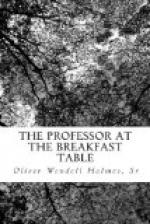The soul, having studied the article of which it finds itself proprietor, thinks, after a time, it knows it pretty well. But there is this difference between its view and that of a person looking at us:—we look from within, and see nothing but the mould formed by the elements in which we are incased; other observers look from without, and see us as living statues. To be sure, by the aid of mirrors, we get a few glimpses of our outside aspect; but this occasional impression is always modified by that look of the soul from within outward which none but ourselves can take. A portrait is apt, therefore, to be a surprise to us. The artist looks only from without. He sees us, too, with a hundred aspects on our faces we are never likely to see. No genuine expression can be studied by the subject of it in the looking-glass.
More than this; he sees us in a way in which many of our friends or acquaintances never see us. Without wearing any mask we are conscious of, we have a special face for each friend. For, in the first place, each puts a special reflection of himself upon us, on the principle of assimilation you found referred to in my last record, if you happened to read that document. And secondly, each of our friends is capable of seeing just so far, and no farther, into our face, and each sees in it the particular thing that he looks for. Now the artist, if he is truly an artist, does not take any one of these special views. Suppose he should copy you as you appear to the man who wants your name to a subscription-list, you could hardly expect a friend who entertains you to recognize the likeness to the smiling face which sheds its radiance at his board. Even within your own family, I am afraid there is a face which the rich uncle knows, that is not so familiar to the poor relation. The artist must take one or the other, or something compounded of the two, or something different from either. What the daguerreotype and photograph do is to give the features and one particular look, the very look which kills all expression, that of self-consciousness. The artist throws you off your guard, watches you in movement and in repose, puts your face through its exercises, observes its transitions, and so gets the whole range of its expression. Out of all this he forms an ideal portrait, which is not a copy of your exact look at any one time or to any particular person. Such a portrait cannot be to everybody what the ungloved call “as nat’ral as life.” Every good picture, therefore, must be considered wanting in resemblance by many persons.
There is one strange revelation which comes out, as the artist shapes your features from his outline. It is that you resemble so many relatives to whom you yourself never had noticed any particular likeness in your countenance.
He is at work at me now, when I catch some of these resemblances, thus:
There! that is just the look my father used to have sometimes; I never thought I had a sign of it. The mother’s eyebrow and grayish-blue eye, those I knew I had. But there is a something which recalls a smile that faded away from my sister’s lips—how many years ago! I thought it so pleasant in her, that I love myself better for having a trace of it.




